Places Visited: Wyoming: Fort Laramie, Guernsey and Casper (North Platte
River, US-26 and I-25)
July 7 & 8 2006: Casper East RV-Park Casper,
Wyoming. Casper East RV-Park is a mom and pop operation without a mom & pop!
N42° 51.357' W106° 17.338' $24 for water & 30-amps central sewage.
They feature gravel interior roads & pads: This is NOT a destination campground
by any means however, it certainly looks much better than the Fort Casper RV-Park
which is nothing but a crowded dusty dirt parking lot.
Joyce had
Wind River Canyon picked as our outing for today. We are in Casper, Wyoming and
have to travel from Casper to Shoshoni on US-20/26 to get there.
Locals
Consider the drive between Casper and Shoshoni as the "longest drive in the
state." Low, rolling, sagebrush-covered hills, not much to see on the horizon,
and the sheer distance from "civilization" contributes to this sentiment.
But the geology can be interesting for those not accoustomed to this terrain.
Looking for subtle changes in the landscape keeps us interested.
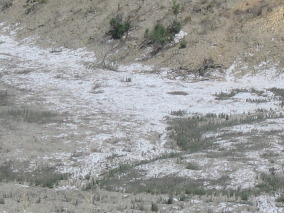
Between
Casper and Powder River we are able to spot occasional outcrops of shale then
as the elevation drops to Powder River we are able to discern spots of white caliche.
Caliche soils occur in low areas where water stands in winter and evaporates in
summer, leaving a residue of salts and calcium carbonate.

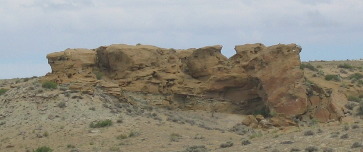
"Hoodoos,"
strongly eroded outcrops that take on human-like forms appear a few miles east
of Shoshoni.
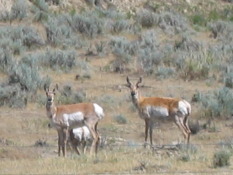
Sagebush
is the predominant vegation and pronghorn antilope are the predominant animal
visible on that long lonely drive from Casper to Shoshoni.
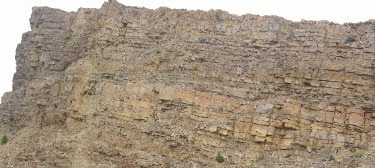
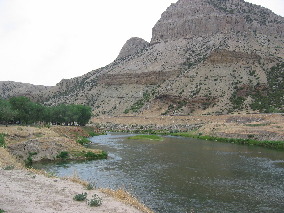
Wind
River Canyon is one of those special places that isn't ballahoed in promotional
literature for some reason. The Canyon offers one of the best exposed and complete
sections of sedimentary rocks anywhere.
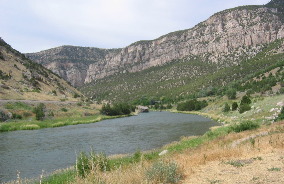
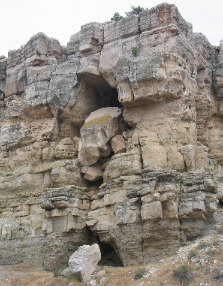
Over
100-million years of sedimentary rocks are exposed in the canyon.
This sandstone
formation has weathered with several large bolder becoming dislodged.
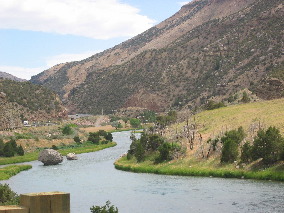
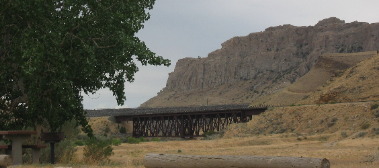
Here
are some bolders that came dislodged from the cliffs above and actually rolled
into the Wind River.
While the picture on the right is of a magnificent
cliff exposing 100-million years of geological history.
The
canyon has been cut/created by the Wind River through the Owl Creek Mountains.
In one of those hard to explain things as the Wind River emerges from the north
end of the canyon, it becomes the Bighorn River and flows north through the Bighorn
Basin and the northern Bighorn Mountains, eventually emptying into the Yellowstone
River in Montana. The Wind River not only changes names along it's course it flows
north. I would say that is a pretty unique river.
It would have seemed,
at least to me that the Wind River would flow east like the North Platte that
we had been following, but no the Wind River runs north. It really doesn't seem
logical. The two rivers are only 100-miles apart in this part of Wyoming. Geologist
say the river had its birth during a time when this area was relatively flat created
by erosion of the mountains with that deposition in the basins. It was also a
very dry period. Streams established their courses at this time, totally indifferent
to the fact that they were flowing over buried uplifts of Precambrian rock and
strata (Precambrian is very hard rock consisting of granite, genesis and schist).
In the last 2-million years the climate has become weter and the Rocky Mountains
were uplifted; this caused the streams to downcut their channels. If a section
of channel was over a buried uplift, like the Owl Creek Range, the river cut into
the underlying rocks and eventually formed a canyon. In summary this seemingly
illogical course was due to the fact that the Wind Rivers Course was determined
before the present landscape of ranges and basins existed.
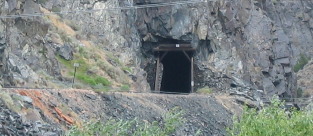
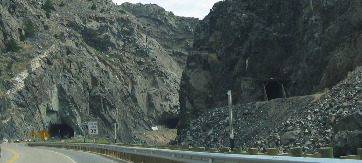
The
Wind River cutting through the extremely hard Precambrian rock in Wind River Canyon
is exactly what we saw in the Royal Gorge in Colorado where the Arkansas River
did the same thing. The Wind River cut such a narrow canyon through this hard
rock that there wasn't enough room for railroad tracks and a highway. The only
way for engineers to follow the river with trains and highways was a series of
tunnels. The highway has three tunnels in a row. On the otherside of a river train
tracks are darting in and out of a series of tunnels. In the picture on the right
that is a railroad tunnel on the other side of the Wind River, while the other
two tunnels are for the highway on this side of the river.
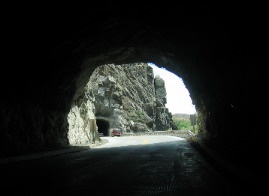
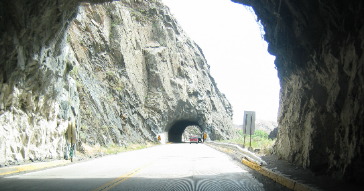
While
the vertical cliffs through Wind River Canyon are not as spectacular as the cut
through Royal Gorge it is more spectacular in other ways. Joyce snapped this series
of pictures as we darted from one tunnel to the other.
It
is easy not to know anything at all about Wind River Canyon because it is not
advertised. However, when in this part of the world it is certainly something
that you should take time to visit. Wind River Canyon is located between Shoshone
and Thermopolis, Wyoming on US-20.

Today
we are entering from Shoshone at the south end of the north/south trending canyon.
The first thing you see as you turn north out of Shoshone is the Owl Mountains
stretching east and west across the horizon.
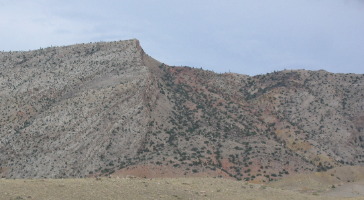
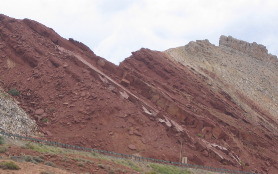
The
closer we get to the mouth of the canyon we see stark evidence of major faulting.
Huge sections of sedimentary rock are thrust skyward at 45-degree angles. What
is unusual about this faulting is while looking in the same place you can see
those angles going in bizzar directions--as in they were nor all going the same
way and at the same angle.
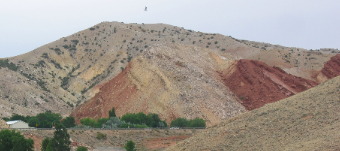
This
is a region of complex faulting. Geologist call this "roll-over" or
arching. This occurs when fault lines don't run perpendicular to the earth's crust.
If you can imagine cutting a section of apple then squeezing the apple to force
that cut section to rise out of it's original place. That is what has taken place
here except there were many slices/cuts/faults that were pushed up or squeezed
down and they can be seen with the naked eye. What geologist ramble on an on about
in books can be seen here. One only need to stop and look at the variety of angles
on the uplifted strata of sedimentary rock to understand that some phenomenal
force caused this.
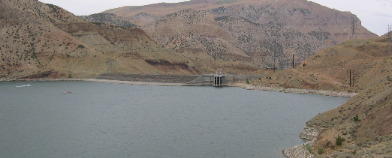
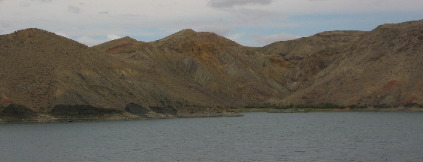
Boisen
Dam across the Wind River has created a huge reservoir in this otherwise arid
region. Our eyes have a hard time concentrating on the faulting and esposed sedimentary
rocks while at the same time trying to ignore this beautiful lake in the middle
of an otherwise desert.
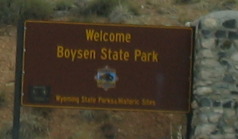
Boisen
State Park is at the entrance to the canyon so we stopped there and paid our $4
entrance fee to drive around and look at the facilities while getting a closer
look at the reservoir.
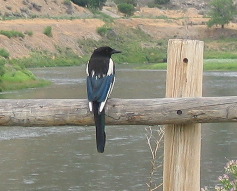
Joyce
snapped this picture of a magpie while we were stopped in one of the campgrounds
of the Boisen State Park scattered along the banks of the Wind River in the Canyon.
This
was an awsome drive for us. We came through the Wind River Canyon in our motorhome
back in 2002 and realized how special this canyon was. Since then we have wanted
to return when we had more time to explore and savor the sights.
Until next
time remember how good life is.
Mike & Joyce Hendrix